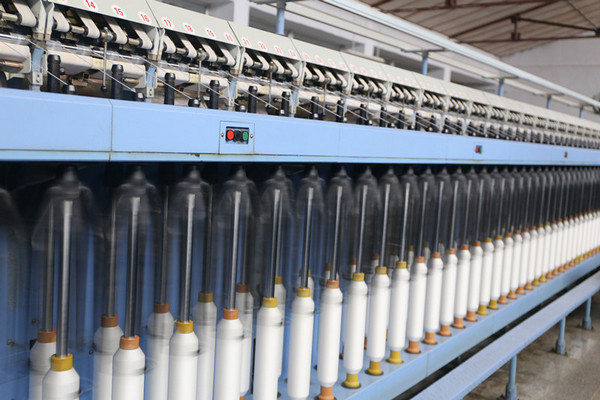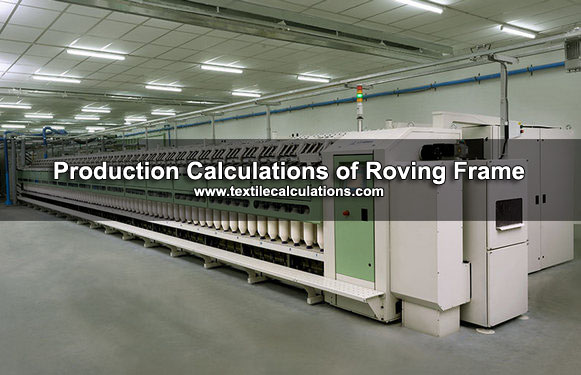Introduction
Roving Frame or Speed Frame or Simplex is the machine of a spinning mill, where the sliver is subjected to one or more attenuating process and the attenuated sliver receives a small amount of twist and is then wound on bobbins. The output product of speed frame machine is called Roving. So it is also called roving frame. The main operations of roving frame are Drafting, Twisting, Winding and Building. Also have two auxiliary operations: Creeling and Doffing. Calculations play an important role in roving frame section. Some important production calculations (Draft, TPI, DCP, TCP, Machine Efficiency, Machine Production, Production Loss etc.) of roving frame machine are discussed below.

Some Important Conversion Factors:
- 36 inch = 3 Feet = 1 Yard;
- 1 Meter = 1.0936 Yards;
- 1 Pound(lb) = 453.6 Gram = 16 Ounce (Oz);
- 1 Lea = 120 Yards;
- 840 Yard = 7 Lea = 1 Hank;
- 1 Pound (lb) = 7000 Grains;
- 1 Meter = 39.37 Inch;
- 1 Kg = 2.205 Pound (lb)
- Count means the number of 840 yards length that weight exactly 1 pound (lb)
- DCP = Draft Change Pinion
- TCP = Twist Change Pinion
- TPI = Twist Per Inch
- TM = Twist Multiplier
Roving Frame Machine Production Calculations
1. TPI = TM √ (Roving Count) [Indirect System]
…………………………………………..Spindle Speed x No of Spindle x Efficiency x 60
2. Production (in lb) per Hour = —————————————————————————-
…………………………………………………….TPI x 36 x 840 x Roving Hank (Ne)
Example: Find out the TPI and Production calculations (in lb) per hour of a modern roving frame at 85% efficiency to produce 1.5 hank roving. Here, No. of spindle = 120 and Spindle speed = 1200 rpm. [TM = 1.1]
Solution:
Here given,
Roving Count = 1.5 Ne
TM = 1.1
No of Spindle = 120
Spindle Speed = 1200 RPM
Efficiency = 85% = 0.85
TPI = TM √ (Roving Count)
= 1.1 x √ (1.5) = 1.347 (Ans)
…………………………………….Spindle Speed x No of Spindle x Efficiency x 60
Production per hour = ————————————————————————-
………………………………………………TPI x 36 x 840 x Roving Hank (Ne)
…1200 x 120 x 0.85 x 60
= ————————————— lbs
….1.347 x 36 x 840 x 1.5
= 120.19 lbs (Ans)
……………………….Flyer Speed/Spindle Speed (RPM)
3. Twist or TPI = ——————————————————————
………………………..Front Roller Delivery (inch/min)
………………Surface Speed of Front Roller
4. Draft = ——————————————————-
………………Surface Speed of Back Roller
5. Surface Speed of Roller = π x Roller Dia x RPM of Roller
Example: Calculate the TPI on simplex if the diameter of back roller is 15/16’’, rpm of B.R is 10, rpm of flyer is 1000 and draft is 6.
Solution:
Given Here,
Back Roller Dia = 15/16” = 0.9375”
RPM of Back Roller = 10
RPM of Flyer = 1000
Draft = 6
Surface Speed of Back Roller = π x B.R. Dia x RPM of B.R.
= 3.1416 x 0.9375 x 10 inch/min
= 29.4525 inch/min
…………Surface Speed of Front Roller
Draft = ————————————————–
………….Surface Speed of Back Roller
Or, Surface Speed of Front Roller = Draft x Surface Speed of Back Roller
= 6 x 29.4525 inch/min
= 176.715 inch/min
So, Front Roller Delivery = 176.715 inch/min
……….Flyer Speed/Spindle Speed (RPM)
TPI = ——————————————————-
………..Front Roller Delivery (inch/min)
………1000
= —————– = 5.66 (Ans)
…..176.715
6. Front Roller Delivery = πDN
….Spindle Speed
= —————————
…………TPI
Example: Calculate the TPI of a speed frame; here spindle speed = 822 RPM, front roller speed = 77 RPM, Circumference of front roller = 8.25”.
Solution:
Here given,
Spindle Speed = 822 RPM
Front Roller Speed, N = 77 RPM
Circumference of Front Roller, 2πR = 8.35”
Front Roller Delivery = πDN = 2πRN
= 8.25 x 77 inch/min
= 635.25 inch/min
…………..Spindle Speed
TPI = —————————————
………Front Roller Delivery
………822
= ————– = 1.29 (Ans)
……635.25
7. Present DCP x Present Hank = Required DCP x Required Hank
Example: If, present DCP of a speed frame is 30T, present roving hank is 1.5 Ne and required roving hank is 2.0 Ne, then what will be the required DCP?
Solution:
Here given,
Present DCP = 30T
Present Roving Hank = 1.5 Ne
Required Roving Hank = 2.0 Ne
………………………..Present DCP x Present Roving Hank
Required DCP = ————————————————————
…………………………………Required Roving Hank
….30 x 1.5
= —————-
……..2.0
= 22.5 ≈ 23 T (Ans)
………………Delivery Hank
8. Draft = —————————-
………………..Feed Hank
9. Present Draft x Present DCP = Required Draft x Required DCP
Example: Find out the DCP required to produce 1.5 hank roving from the sliver of 60 grains/yard. When, Present DCP = 60, Present Roving hank = 0.74 and Present Sliver = 68 grains/yard.
Solution:
Here given,
Present DCP = 60 T
Present Roving hank (Delivery Hank) = 0.78
Present Sliver, W = 68 grains/yard = 68/7000 = 0.0097 lbs/yard
S0, L = 1 yard
………………….L x w 1 x 1
Feed Hank = ———– = ————————— = 0.123 Ne
………………….W x l 0.0097 x 840
Required Roving Hank (Delivery Hank) = 1.5 Ne
……………………….Delivery hank (Present)
Present Draft = —————————————
………………………………Feed Hank
……0.78
= —————- = 6.34
….0.123
………………………..Delivery Hank (Required)
Required Draft = ——————————————-
………………………………….Feed Hank
……..1.5
= ————-= 12.19
…..0.123
Present Draft x Present DCP = Required Draft x Required DCP
………………………………Present Draft x Present DCP
Or, Required DCP = ————————————————-
………………………………………..Required Draft
…6.34 x 60
= —————– = 31.2 ≈ 31 T (Ans)
….12.19
…………………………………………….π x Roller Dia x Roller Speed x Effi. x 60 x 8
10. Production (in lb) Per Shift = ———————————————————————
………………………………………………………36 x 840 x Roving Hank (Ne)
Example: Front Roller Dia = 1.125”, Front Roller RPM = 185, Efficiency = 85%, If Roving Hank is 0.8 Ne, Find out the production in lb per shift.
Solution:
Here given,
Roving Hank = 0.8 Ne
Front Roller Dia = 1.125”
Front Roller Speed = 185 RPM
Efficiency = 85% = 0.85
……………………………………………..π x Front Roller Dia x Front Roller Speed x Effi. x 60 x 8
Production (in lb) per Shift = ———————————————————————————-
…………………………………………………………………..36 x 840 x Roving Hank (Ne)
…3.1416 x 1.125 x 185 x 0.85 x 60 x 8
= —————————————————— lbs
………………36 x 840 x 0.8
= 11.03 lbs (Ans)
………………………………..Total Shift Time – Total Stoppage Time
11. Machine Efficiency = ——————————————————————- x 100
……………………………………………….Total Shift Time
………………………………………….Flyer Speed (rpm) x No of Spindle x Effi. x 60 x 8
12. Machine Production per Shift = ———————————————————————–
…………………………………………………………..TPI x 36 x 840 x Roving Hank
Example:
Machine Data:
Flyer Speed = 950 RPM
Roving Hank = 0.8 Ne
No of Spindle = 120
TPI = 1.35
Time Data:
Total Shift Hours = 8 hrs
Doffing Time = 50 Mins
Roving Breakage Time = 20 Mins
Other Stoppage Time = 27 Mins
Solution:
Total Stoppage Time = Doffing Time + Roving Breakage Time + Other Stoppage Time
= 50 + 20 + 27 = 97 Mins
Total Shift Time = 8 hrs = 480 Mins
………………………………..480 – 97
Machine Efficiency = ——————- x 100
…………………………………..480
= 79.79% (Ans)
…………………………………..Flyer Speed (rpm) x No of Spindle x Efficiency x 60 x 8
Machine Production = ————————————————————————————
……………………………………………………….TPI x 36 x 840 x Roving Hank
…..950 x 120 x 79.79 x 60 x 8
= —————————————– lbs/shift
….1.35 x 36 x 840 x 100 x 0.8
= 1336.87 lbs/shift (Ans)
13. Production Loss in Spindle – Hour = No of Spindle x Time in Hour
……………………………………………………….OPS x Spindle – Hour
14. Production Loss (in lb) Per Hour = —————————————–
…………………………………………………………………16 x 8
Example: Find out the Production loss/shift in lbs of a simplex was stopped for 40 mins due to roving breakage. (Assume necessary parameters)
Solution:
Here given,
Time of stoppage = 40 mins = 40/60 = 0.67 hour
Let, No of spindle = 120
Production in 03 per spindle = 160
Now, Production loss in spindle – hour = No of Spindle x Time in Hour
= 120 x 0.67 = 80
……………………………………………..OPS x Spindle-hour
Production loss in lb per shift = ————————————-
……………………………………………………….16 x 8
…160 x 80
= —————— lbs
….16 x 8
= 100 lbs (Ans)
15. Twist Constant = TPI x TCP
Example: Find out the Twist Constant to produce 1.5 hank roving where spindle rpm = 1200, front roller speed = 80 rpm, front roller dia = 1.25”, twist change pinion = 28 T. Also calculate the required TCP.
Solution:
Here Given,
Spindle Speed = 1200 RPM
Front Roller Speed, N = 80 RPM
Front Roller Dia, D = 1.25”
TCP = 28 T
Required Hank = 1.5 Ne
Front Roller Delivery = πDN = 3.1416 x 1.25 x 80 inch/min
= 314.16 inch/min
…………………………………Spindle Speed (rpm)
We Know, TPI = ——————————————————-
……………………….Front Roller Delivery (inch/min)
…..1200
= ————— = 3.82
…314.16
Twist Constant = TPI x TCP
= 3.82 x 28
= 106.96
Required TPI = TM x √ (Hank) [Let, TM = 1.1]
= 1.1 x √ 1.5
= 1.347
………………………….106.96
Required TCP = —————- = 79.4 ≈ 79 (Ans)
…………………………..1.347
Conclusion
I have tried to explain the production and other calculations formulas (such as Draft, Twist or TPI, TCP, Twist Constant, DCP, Machine efficiency, Machine Production, Production Loss etc.) with examples of Roving Frame (Speed Frame or Simplex) machine through this article. Hope this article will be helpful for those who are new to the spinning mill or those who are students.
Author of this Article:
Md. Imran Hossain
B.Sc. in Textile Engineering
Shahid Abdur Rab Serniabat Textile Engineering College, Barisal.
Email: [email protected]
You may also like:

